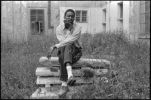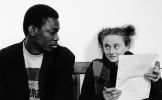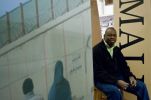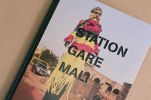“Apres une colaboration avec Anna quit consistant a lʼinstallation dʼune tente, et photos dans une chambre qui occupait les militares au paravant.
“Ce travait qui avait pour moi une double signification: Á une part une seconte Nord-Sud qui enguidre la solidarité, L’egalité, la communion de tout dans un Esprit de la Creativité.
“Et d’antre pour le coté humanistique de l’ouvre qui est de’voir une tente dans une maison. Inspiré pour l’environment etlim de travail et contant l’amour, la solidarité, l’egalité et le tout dans la paix l’ideé sui’est venu de faire quelque chose qui dans cette maison qui interpelle tout un chacun de reflectier sur le contraire de la paix. Mois Hélas cette par tes enemies Aujourd’hut encore ou le monde se dit civilisé, developpe moderne, et qui il existe encore des guerres tribales, histoires de frontiere, differance de coleuers ou de culture on entre tue l’ideé qui me vient constamment c’est What do we do now? Alors profitant de ma presence dans monastery qui a ete’aussi victime de cela j’ai fait cette peinture. Cette peinture est une representation de doux enfants desamparés an milieu d’une guerre et qui se demande que faire maitenant….”
Hama Goro, 1995
In cooperation with Anna Best, I created an installation consisting of a tent and photographs, displayed in a room that was used by the Soviet Army (1945 or 1968).
The work for me had a double meaning:
Firstly, the North-South axis, embodying solidarity: equality and connection of everything in one Creative Spirit.
Secondly, there was a humanistic aspect: the tent was put inside the building. I was inspired by the creative atmosphere of the symposium, and when I began to think about Love, Solidarity, Equality, and Peace, it occurred to me to do something that would lead towards the opposite of peace. Even today, when we supposed to live in a civilized, developed and modern world, tribal wars are happening and people are killing each other. Because of borders, or because of racial and cultural differences. I often wonder: What are we going to do now? (What do we do now?). While being in a monastery (which also carries traces of suffering) I made this painting. It shows two helpless children in the middle of the war. One asks the other to think what we are going to do?
Hama Goro, 1995
Hama Goro was born 1963 in a Dogon village called Dinangourou in Mali. He started his artistic career in 1987, after studies at the National Art Institute of Bamako (INA), where he received his degree in drawing and visual arts. After several solo and group exhibitions in Mali and around the world, he was awarded a UNESCO–Aschberg scholarship in 1994 for professional training at the Rijksakademie Van Beeldende Kunsten in Amsterdam. He invested in research for the development of this sector, where he was one of the initiators of the_ Centre Soleil d’Afrique_ in Bamako in 1999. He headed Soleil d’Afrique since its creation, turning the center into a framework to offer Malian artists a creative space. Goro is one of the founding members of KYA Network (the network of Malian cultural actors) for the promotion and development of art and culture in Mali, Aterial Network, and Rain Network, among others.






